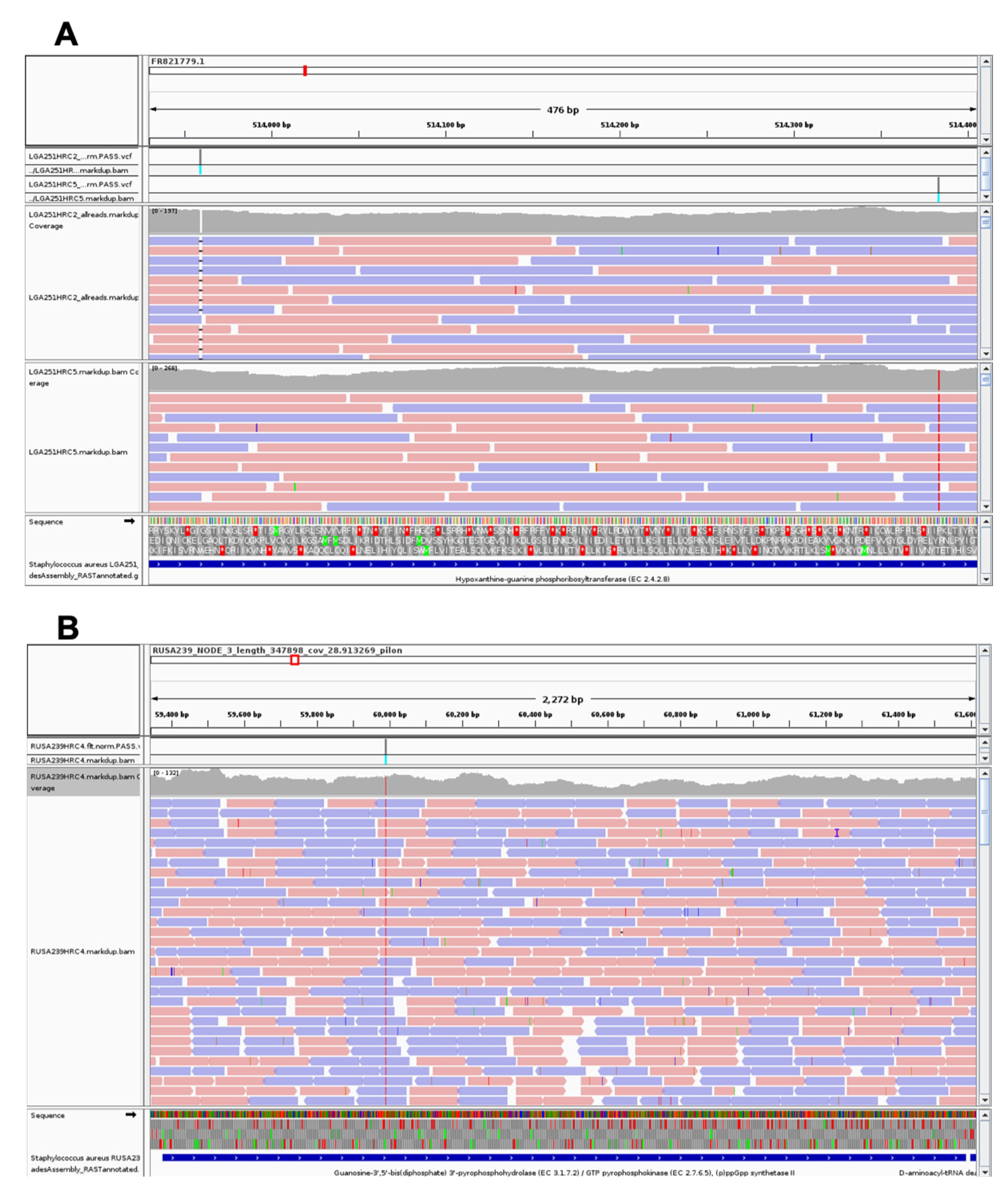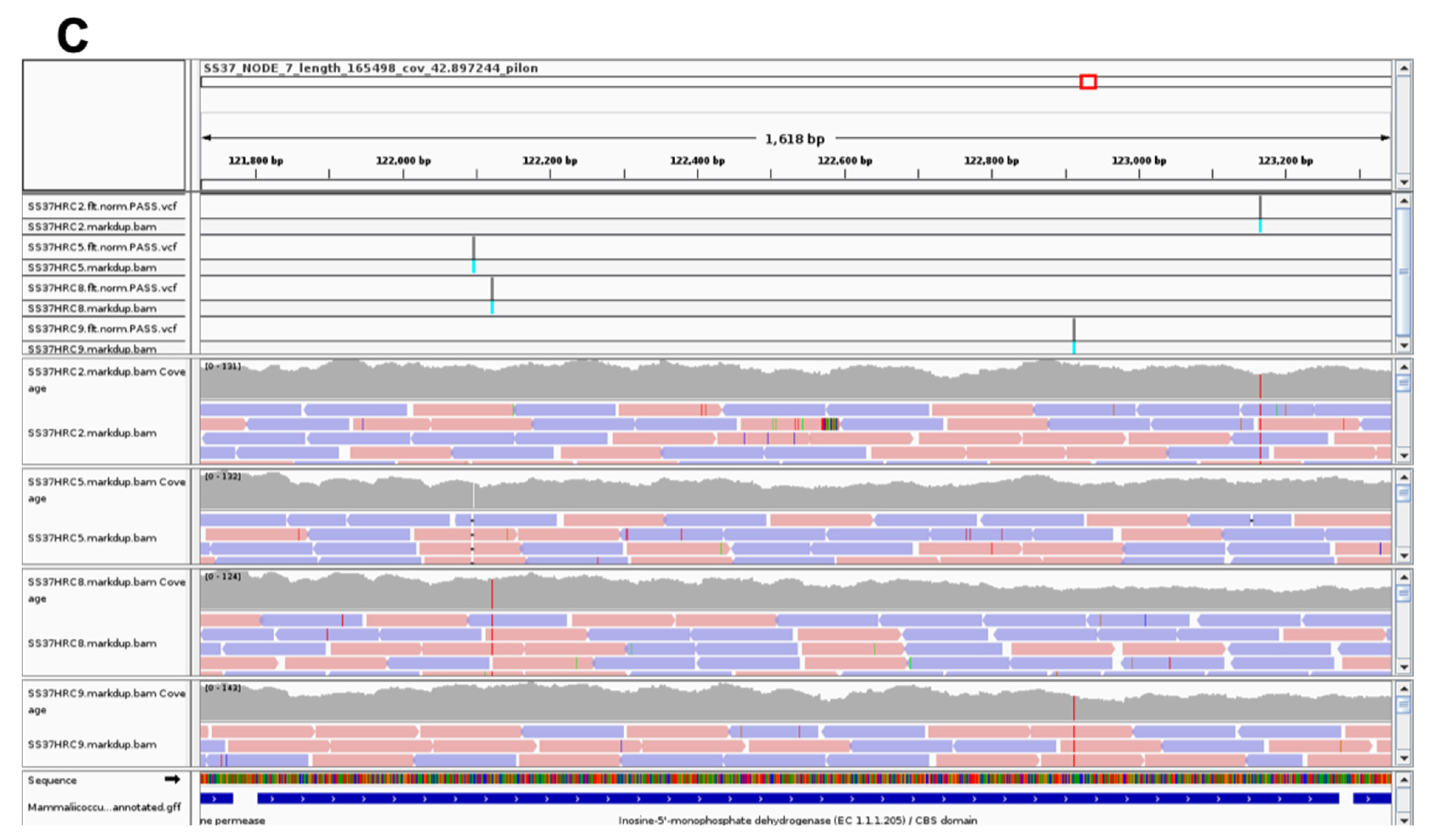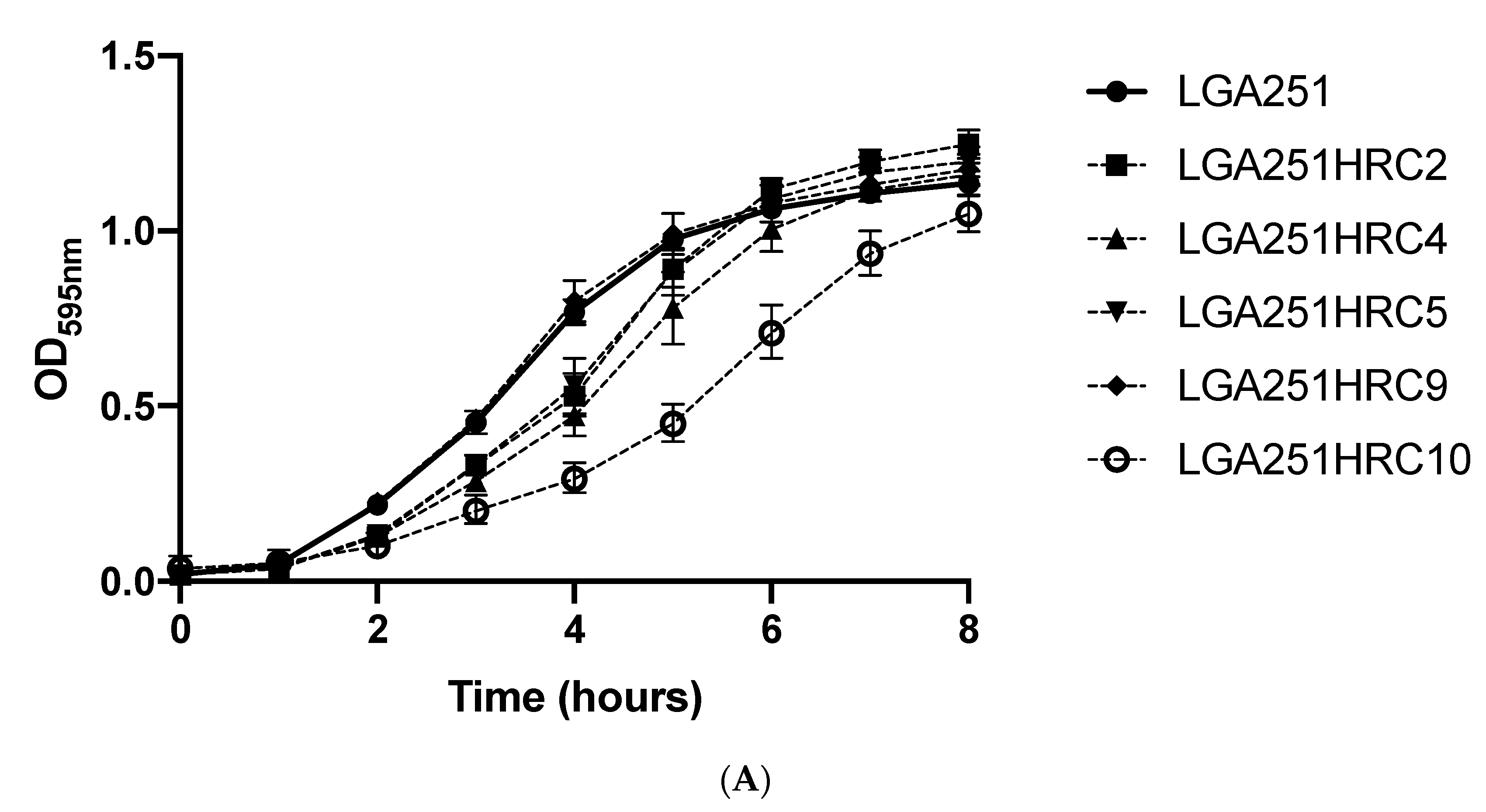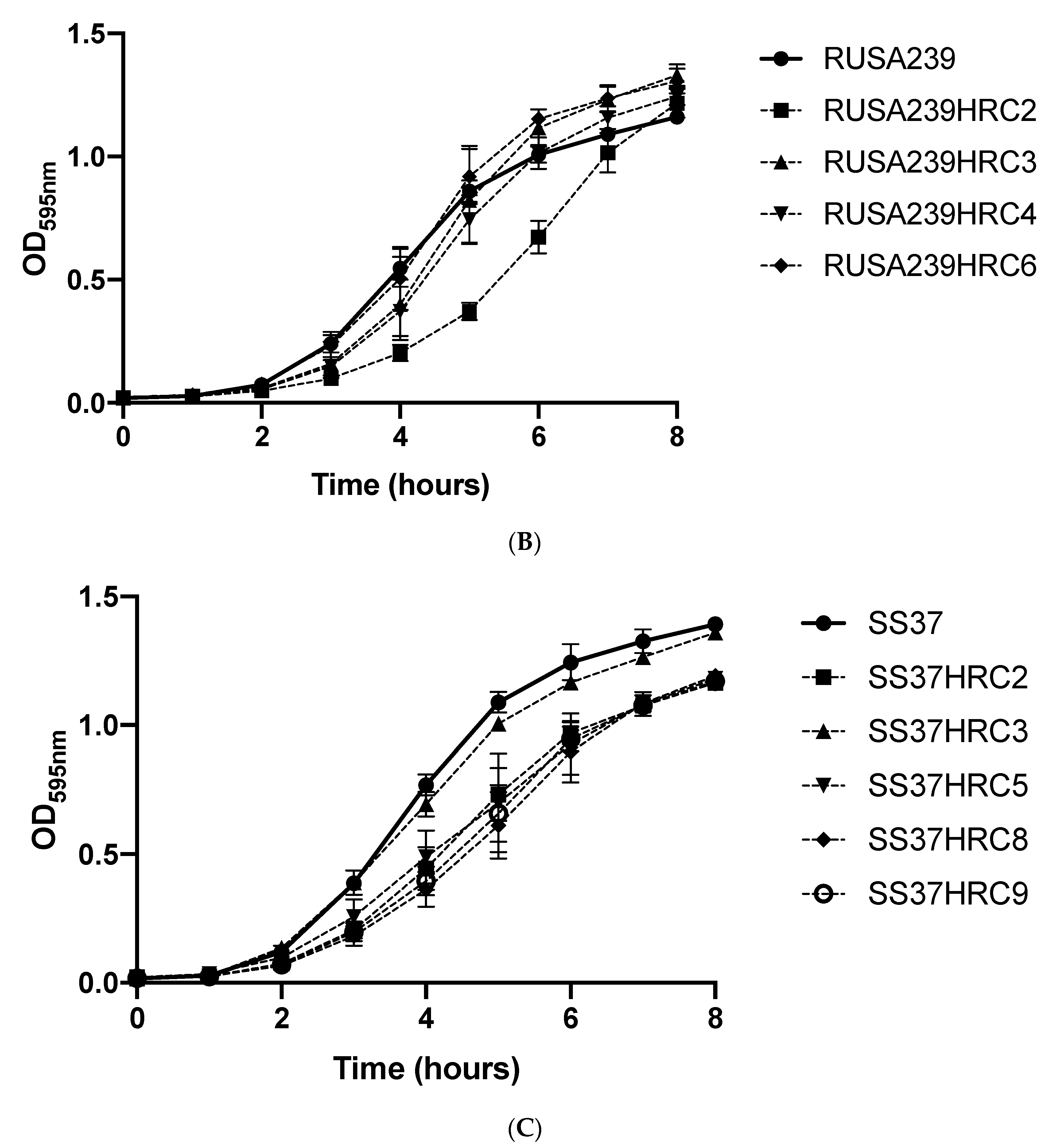Impact of the Stringent Stress Response on the Expression of Methicillin Resistance in Staphylococcaceae Strains Carrying mecA, mecA1 and mecC
Abstract
:1. Introduction
2. Results
2.1. Selection of Homogenous Highly Resistant (H*R) Subpopulations
2.2. Whole-Genome Sequencing of Parental Strains and Their Subpopulations
2.3. Affected Genes and Their Functional Category
3. Discussion
4. Materials and Methods
4.1. Bacterial Strains, Media, and Growth Conditions
4.2. Antibiotic Susceptibility
4.3. Selection of Homogenous Highly Resistant Subpopulations
4.4. Whole-Genome Sequencing
4.5. Accession Number(s)
4.6. Growth Curves
Supplementary Materials
Author Contributions
Funding
Institutional Review Board Statement
Informed Consent Statement
Data Availability Statement
Conflicts of Interest
References
- Inagaki, K.; Lucar, J.; Blackshear, C.; Hobbs, C.V. Methicillin-susceptible and Methicillin-resistant Staphylococcus aureus Bacteremia: Nationwide Estimates of 30-Day Readmission, In-hospital Mortality, Length of Stay, and Cost in the United States. Clin. Infect. Dis. 2019, 69, 2112–2118. [Google Scholar] [CrossRef] [PubMed]
- Hartman, B.J.; Tomasz, A. Low-affinity penicillin-binding protein associated with β-lactam resistance in Staphylococcus aureus. J. Bacteriol. 1984, 158, 513–516. [Google Scholar] [CrossRef] [PubMed] [Green Version]
- Becker, K.; van Alen, S.; Idelevich, E.A.; Schleimer, N.; Seggewiss, J.; Mellmann, A.; Kaspar, U.; Peters, G. Plasmid-Encoded Transferable mecB-Mediated Methicillin Resistance in Staphylococcus aureus. Emerg. Infect. Dis. 2018, 24, 242–248. [Google Scholar] [CrossRef] [PubMed] [Green Version]
- Kim, C.; Milheiriço, C.; Gardete, S.; Holmes, M.A.; Holden, M.T.G.; de Lencastre, H.; Tomasz, A. Properties of a novel PBP2A protein homolog from Staphylococcus aureus strain LGA251 and its contribution to the β-lactam-resistant phenotype. J. Biol. Chem. 2012, 287, 36854–36863. [Google Scholar] [CrossRef] [PubMed] [Green Version]
- Ballhausen, B.; Kriegeskorte, A.; Schleimer, N.; Peters, G.; Becker, K. The mecA homolog mecC confers resistance against beta-lactams in Staphylococcus aureus irrespective of the genetic strain background. Antimicrob. Agents Chemother. 2014, 58, 3791–3798. [Google Scholar] [CrossRef] [Green Version]
- International Working Group on the Classification of Staphylococcal Cassette Chromosome Elements IWG-SCC. Classification of staphylococcal cassette chromosome mec (SCCmec): Guidelines for reporting novel SCCmec elements. Antimicrob. Agents Chemother. 2009, 53, 4961–4967. [Google Scholar] [CrossRef] [Green Version]
- García-Álvarez, L.; Holden, M.T.G.; Lindsay, H.; Webb, C.R.; Brown, D.F.J.; Curran, M.D.; Walpole, E.; Brooks, K.; Pickard, D.J.; Teale, C.; et al. Meticillin-resistant Staphylococcus aureus with a novel mecA homologue in human and bovine populations in the UK and Denmark: A descriptive study. Lancet Infect. Dis. 2011, 11, 595–603. [Google Scholar] [CrossRef] [Green Version]
- Shore, A.C.; Deasy, E.C.; Slickers, P.; Brennan, G.; O’Connell, B.; Monecke, S.; Ehricht, R.; Coleman, D.C. Detection of staphylococcal cassette chromosome mec type XI carrying highly divergent mecA, mecI, mecR1, blaZ, and ccr genes in human clinical isolates of clonal complex 130 methicillin-resistant Staphylococcus aureus. Antimicrob. Agents Chemother. 2011, 55, 3765–3773. [Google Scholar] [CrossRef] [Green Version]
- Loncaric, I.; Kübber-Heiss, A.; Posautz, A.; Ruppitsch, W.; Lepuschitz, S.; Schauer, B.; Feßler, A.T.; Krametter-Frötscher, R.; Harrison, E.M.; Holmes, M.A.; et al. Characterization of mecC gene-carrying coagulase-negative Staphylococcus spp. isolated from various animals. Vet. Microbiol. 2019, 230, 138–144. [Google Scholar] [CrossRef]
- Baba, T.; Kuwahara-Arai, K.; Uchiyama, I.; Takeuchi, F.; Ito, T.; Hiramatsu, K. Complete genome sequence of Macrococcus caseolyticus strain JCSCS5402, reflecting the ancestral genome of the human-pathogenic staphylococci. J. Bacteriol. 2009, 191, 1180–1190. [Google Scholar] [CrossRef] [Green Version]
- Tsubakishita, S.; Kuwahara-Arai, K.; Baba, T.; Hiramatsu, K. Staphylococcal cassette chromosome mec-like element in Macrococcus caseolyticus. Antimicrob. Agents Chemother. 2010, 54, 1469–1475. [Google Scholar] [CrossRef] [Green Version]
- Madhaiyan, M.; Wirth, J.S.; Saravanan, V.S. Phylogenomic analyses of the Staphylococcaceae family suggest the reclassification of five species within the genus Staphylococcus as heterotypic synonyms, the promotion of five subspecies to novel species, the taxonomic reassignment of five Staphylococcus species to Mammaliicoccus gen. nov., and the formal assignment of Nosocomiicoccus to the family Staphylococcaceae. Int. J. Syst. Evol. Microbiol. 2020, 70, 5926–5936. [Google Scholar] [PubMed]
- Couto, I.; De Lencastre, H.; Severina, E.; Kloos, W.; Webster, J.A.; Hubner, R.J.; Sanches, I.S.; Tomasz, A. Ubiquitous presence of a mecA homologue in natural isolates of Staphylococcus sciuri. Microb. Drug Resist. 1996, 2, 377–391. [Google Scholar] [CrossRef] [PubMed]
- Couto, I.; Sanches, I.S.; Sá-Leão, R.; De Lencastre, H. Molecular characterization of Staphylococcus sciuri strains isolated from humans. J. Clin. Microbiol. 2000, 38, 1136–1143. [Google Scholar] [CrossRef] [PubMed] [Green Version]
- Davies, J.; Davies, D. Origins and evolution of antibiotic resistance. Microbiol. Mol. Biol. Rev. 2010, 74, 417–433. [Google Scholar] [CrossRef] [Green Version]
- Larsen, J.; Raisen, C.L.; Ba, X.; Sadgrove, N.J.; Padilla-González, G.F.; Simmonds, M.S.J.; Loncaric, I.; Kerschner, H.; Apfalter, P.; Hartl, R.; et al. Emergence of methicillin resistance predates the clinical use of antibiotics. Nature 2022, 602, 135–141. [Google Scholar] [CrossRef]
- Dordel, J.; Kim, C.; Chung, M.; Pardos de la Gandara, M.; Holden, M.T.J.; Parkhill, J.; de Lencastre, H.; Bentley, S.D.; Tomasz, A. Novel determinants of antibiotic resistance: Identification of mutated loci in highly methicillin-resistant subpopulations of methicillin-resistant Staphylococcus aureus. mBio 2014, 5, e01000-13. [Google Scholar] [CrossRef] [Green Version]
- Pardos de la Gandara, M.; Borges, V.; Chung, M.; Milheiriço, C.; Gomes, J.P.; de Lencastre, H.; Tomasz, A. Genetic Determinants of High-Level Oxacillin Resistance in Methicillin-Resistant Staphylococcus aureus. Antimicrob. Agents Chemother. 2018, 62, e00206-18. [Google Scholar] [CrossRef] [Green Version]
- De Lencastre, H.; Wu, S.W.; Pinho, M.G.; Ludovice, A.M.; Filipe, S.; Gardete, S.; Sobral, R.; Gill, S.; Chung, M.; Tomasz, A. Antibiotic resistance as a stress response: Complete sequencing of a large number of chromosomal loci in Staphylococcus aureus strain COL that impact on the expression of resistance to methicillin. Microb. Drug Resist. 1999, 5, 163–175. [Google Scholar] [CrossRef]
- Berger-Bachi, B.; Strassle, A.; Gustafson, J.; Kayser, F. Mapping and characterization of multiple chromosomal factors involved in methicillin resistance in Staphylococcus aureus. Antimicrob. Agents Chemother. 1992, 36, 1367–1373. [Google Scholar] [CrossRef] [Green Version]
- Keaton, M.A.; Rosato, R.R.; Plata, K.B.; Singh, C.R.; Rosato, A.E. Exposure of clinical MRSA heterogeneous strains to β-lactams redirects metabolism to optimize energy production through the TCA cycle. PLoS ONE 2013, 8, e71025. [Google Scholar] [CrossRef] [PubMed] [Green Version]
- Rosato, R.R.; Fernandez, R.; Paz, L.I.; Singh, C.R.; Rosato, A.E. TCA Cycle-Mediated Generation of ROS Is a Key Mediator for HeR-MRSA Survival under β-Lactam Antibiotic Exposure. PLoS ONE 2014, 9, e99605. [Google Scholar] [CrossRef] [PubMed] [Green Version]
- Ikehara, K.; Okada, H.; Maeda, K.; Ogura, A.; Sugae, K. Accumulation of relA gene-independent ppGpp in Bacillus subtilis vegetative cells upon temperature shift-down. J. Biochem. 1984, 95, 895–897. [Google Scholar] [CrossRef] [PubMed]
- Mwangi, M.M.; Kim, C.; Chung, M.; Tsai, J.; Vijayadamodar, G.; Benitez, M.; Jarvie, T.P.; Du, L.; Tomasz, A. Whole-genome sequencing reveals a link between β-lactam resistance and synthetases of the alarmone (p)ppGpp in Staphylococcus aureus. Microb. Drug Resist. 2013, 19, 153–159. [Google Scholar] [CrossRef] [Green Version]
- Matsuo, M.; Yamamoto, N.; Hishinuma, T.; Hiramatsu, K. Identification of a Novel Gene Associated with High-Level β-Lactam Resistance in Heterogeneous Vancomycin-Intermediate Staphylococcus aureus Strain Mu3 and Methicillin-Resistant S. aureus Strain N315. Antimicrob. Agents Chemother. 2019, 63, e00712-18. [Google Scholar] [CrossRef] [Green Version]
- Milheiriço, C.; de Lencastre, H.; Tomasz, A. Full-Genome Sequencing Identifies in the Genetic Background Several Determinants That Modulate the Resistance Phenotype in Methicillin-Resistant Staphylococcus aureus Strains Carrying the Novel mecC Gene. Antimicrob. Agents Chemother. 2017, 61, e02500-16. [Google Scholar] [CrossRef] [Green Version]
- Kim, C.K.; Milheiriço, C.; de Lencastre, H.; Tomasz, A. Antibiotic Resistance as a Stress Response: Recovery of High-Level Oxacillin Resistance in Methicillin-Resistant Staphylococcus aureus “Auxiliary” (fem) Mutants by Induction of the Stringent Stress Response. Antimicrob. Agents Chemother. 2017, 61, e00313-17. [Google Scholar] [CrossRef] [Green Version]
- Gaca, A.O.; Kajfasz, J.K.; Miller, J.H.; Liu, K.; Wang, J.D.; Abranches, J.; Lemos, J.A. Basal levels of (p)ppGpp in Enterococcus faecalis: The magic beyond the stringent response. mBio 2013, 4, e00646-13. [Google Scholar] [CrossRef] [Green Version]
- Kriel, A.; Bittner, A.N.; Kim, S.H.; Liu, K.; Tehranchi, A.K.; Zou, W.Y.; Rendon, S.; Chen, R.; Tu, B.P.; Wang, J.D. Direct regulation of GTP homeostasis by (p)ppGpp: A critical component of viability and stress resistance. Mol. Cell 2012, 48, 231–241. [Google Scholar] [CrossRef] [Green Version]
- Liu, K.; Myers, A.R.; Pisithkul, T.; Claas, K.R.; Satyshur, K.A.; Amador-Noguez, D.; Keck, J.L.; Wang, J.D. Molecular mechanism and evolution of guanylate kinase regulation by (p)ppGpp. Mol. Cell 2015, 57, 735–749. [Google Scholar] [CrossRef] [Green Version]
- Prunier, A.-L.; Leclercq, R. Role of mutS and mutL genes in hypermutability and recombination in Staphylococcus aureus. J. Bacteriol. 2005, 187, 3455–3464. [Google Scholar] [CrossRef] [PubMed] [Green Version]
- Kofoed, E.M.; Yan, D.; Katakam, A.K.; Reichelt, M.; Lin, B.; Kim, J.; Park, S.; Date, S.V.; Monk, I.R.; Xu, M.; et al. De Novo Guanine Biosynthesis but Not the Riboswitch-Regulated Purine Salvage Pathway Is Required for Staphylococcus aureus Infection In Vivo. J. Bacteriol. 2016, 198, 2001–2015. [Google Scholar] [CrossRef] [PubMed] [Green Version]
- Morrissey, J.A.; Cockayne, A.; Brummell, K.; Williams, P. The staphylococcal ferritins are differentially regulated in response to iron and manganese and via PerR and Fur. Infect. Immun. 2004, 72, 972–979. [Google Scholar] [CrossRef] [PubMed] [Green Version]
- Sewell, E.W.C.; Brown, E.D. Taking aim at wall teichoic acid synthesis: New biology and new leads for antibiotics. J. Antibiot. 2014, 67, 43–51. [Google Scholar] [CrossRef] [Green Version]
- Layec, S.; Decaris, B.; Leblond-Bourget, N. Diversity of Firmicutes peptidoglycan hydrolases and specificities of those involved in daughter cell separation. Res. Microbiol. 2008, 159, 507–515. [Google Scholar] [CrossRef]
- Corrigan, R.M.; Bellows, L.E.; Wood, A.; Gründling, A. ppGpp negatively impacts ribosome assembly affecting growth and antimicrobial tolerance in Gram-positive bacteria. Proc. Natl. Acad. Sci. USA 2016, 113, E1710–E1719. [Google Scholar] [CrossRef] [Green Version]
- Elbaramawi, S.S.; Ibrahim, S.M.; Lashine, E.-S.M.; El-Sadek, M.E.; Mantzourani, E.; Simons, C. Exploring the binding sites of Staphylococcus aureus phenylalanine tRNA synthetase: A homology model approach. J. Mol. Graph. Model. 2017, 73, 36–47. [Google Scholar] [CrossRef]
- Komatsuzawa, H.; Fujiwara, T.; Nishi, H.; Yamada, S.; Ohara, M.; McCallum, N.; Berger-Bächi, B.; Sugai, M. The gate controlling cell wall synthesis in Staphylococcus aureus. Mol. Microbiol. 2004, 53, 1221–1231. [Google Scholar] [CrossRef]
- Machado, M.P.; Halkilahti, J.; Jaakkonen, A.; Silva, D.N.; Mendes, I.; Nalbantoglu, Y.; Borges, V.; Ramirez, M.; Rossi, M.; Carriço, J.A. INNUca GitHub. Available online: https://github.com/B-UMMI/INNUca (accessed on 14 February 2022).
- Li, H.; Durbin, R. Fast and accurate short read alignment with Burrows-Wheeler transform. Bioinformatics 2009, 25, 1754–1760. [Google Scholar] [CrossRef] [Green Version]
- Li, H. A statistical framework for SNP calling, mutation discovery, association mapping and population genetical parameter estimation from sequencing data. Bioinformatics. 2011, 27, 2987–2993. [Google Scholar] [CrossRef] [Green Version]
- Robinson, J.T.; Thorvaldsdóttir, H.; Winckler, W.; Guttman, M.; Lander, E.S.; Getz, G.; Mesirov, J.P. Integrative genomics viewer. Nat. Biotechnol. 2011, 29, 24–26. [Google Scholar] [CrossRef] [PubMed] [Green Version]
- Seemann, T. Prokka: Rapid prokaryotic genome annotation. Bioinformatics 2014, 30, 2068–2069. [Google Scholar] [CrossRef] [PubMed]
- Brettin, T.; Davis, J.J.; Disz, T.; Edwards, R.A.; Gerdes, S.; Olsen, G.J.; Olson, R.; Overbeek, R.; Parrello, B.; Pusch, G.D.; et al. RASTtk: A modular and extensible implementation of the RAST algorithm for building custom annotation pipelines and annotating batches of genomes. Sci. Rep. 2015, 5, 8365–8366. [Google Scholar] [CrossRef] [PubMed] [Green Version]





| H*R Isolate | Nucleotide Change (5′ → 3′) a | Amino Acid Change | Affected Genes | Locus Tag(s) in Reference Strains b | Product c |
|---|---|---|---|---|---|
| LGA251HRC2 | 66delG | Gly23fs | hpt | SARLGA251_04440 | putative hypoxanthine phosphoribosyltransferase |
| 857450insA | putative pathogenicity island | ||||
| LGA251HRC4 | 1934923G → A | tRNA_48 | tRNA-Met-CAT | ||
| LGA251HRC5 | 490C → T | Arg164 * | hpt | SARLGA251_04440 | putative hypoxanthine phosphoribosyltransferase |
| LGA251HRC9 | 297A → G | Ile99Met | SARLGA251_00130 | putative membrane protein | |
| 1021delA | Asn343fs | mutL | SARLGA251_12070 | DNA mismatch repair protein MutL | |
| LGA251HRC10 | 1934923G → A | tRNA_48 | tRNA-Met-CAT | ||
| RUSA239HRC2 | 761T → C | Phe254Ser | pheS | SACOL1148 | phenylalanyl-tRNA synthetase, alpha subunit |
| RUSA239HRC3 | 2208425C → T | Intergenic region | |||
| RUSA239HRC4 | 595C → T | Gln199 * | relA2 | SACOL1689 | GTP pyrophosphokinase |
| RUSA239HRC6 | 2208422C → A | Intergenic region | |||
| SS37HRC2 | 136A → T | Leu46Met | tagF_2 | NCTC12103_02001 | glycosyl glycerol phosphate transferase involved in teichoic acid biosynthesis |
| 1363C → T | Gln455 * | guaB | NCTC12103_02801 | IMP dehydrogenase/CBS domain | |
| 657delC | Ile219fs | ykfC | NCTC12103_02764 | L-alanyl-gama-D-glutamyl-L-diamino acid endopeptidase—NLPC/P60 family protein | |
| SS37HRC3 | 881C → T | Gly294Asp | ptsI | NCTC12103_01951 | phosphoenolpyruvate-protein phosphotransferase of PTS system |
| 478delT | Met160Trp | NCTC12103_01955 | radical activating enzyme protein | ||
| 419G → A | Ala140Val | purM | NCTC12103_01966 | phosphoribosylformylglycinamidine cyclo-ligase | |
| 227C → T | Gly76Glu | eamB_2 | NCTC12103_02032 | amino acid transporter LysE | |
| 1065A → G | oppA_1 | NCTC12103_02094 | oligopeptide ABC transporter periplasmic oligopeptide-binding protein | ||
| 409insT | Gln137Thr | mutL | NCTC12103_01639 | DNA mismatch repair protein | |
| 517delA | Lys173fs | lutA | NCTC12103_00751 | glycolate oxidase iron-sulfur subunit | |
| 646delT | Thr216Leu | NCTC12103_01160 | Gas vesicle protein | ||
| 353G → A | Ala118Val | sftA | NCTC12103_01157 | cell division protein DNA translocase FtsK | |
| 129C → T | licB_2 | NCTC12103_02427 | phosphotransferase system cellobiose-specific component IIB | ||
| SS37HRC5 | 294delC | Asn98fs | guaB | NCTC12103_02801 | IMP dehydrogenase/CBS domain |
| 331C → T | Glu111Lys | ftnA | NCTC12103_00955 | Bacterial non-heme Ferritin | |
| SS37HRC8 | 400274delT | Intergenic region | |||
| 319C → T | Gln107 * | guaB | NCTC12103_02801 | IMP dehydrogenase/CBS domain | |
| SS37HRC9 | 1111G → T | Glu371 * | guaB | NCTC12103_02801 | IMP dehydrogenase/CBS domain |
Publisher’s Note: MDPI stays neutral with regard to jurisdictional claims in published maps and institutional affiliations. |
© 2022 by the authors. Licensee MDPI, Basel, Switzerland. This article is an open access article distributed under the terms and conditions of the Creative Commons Attribution (CC BY) license (https://creativecommons.org/licenses/by/4.0/).
Share and Cite
Milheiriço, C.; Tomasz, A.; de Lencastre, H. Impact of the Stringent Stress Response on the Expression of Methicillin Resistance in Staphylococcaceae Strains Carrying mecA, mecA1 and mecC. Antibiotics 2022, 11, 255. https://doi.org/10.3390/antibiotics11020255
Milheiriço C, Tomasz A, de Lencastre H. Impact of the Stringent Stress Response on the Expression of Methicillin Resistance in Staphylococcaceae Strains Carrying mecA, mecA1 and mecC. Antibiotics. 2022; 11(2):255. https://doi.org/10.3390/antibiotics11020255
Chicago/Turabian StyleMilheiriço, Catarina, Alexander Tomasz, and Hermínia de Lencastre. 2022. "Impact of the Stringent Stress Response on the Expression of Methicillin Resistance in Staphylococcaceae Strains Carrying mecA, mecA1 and mecC" Antibiotics 11, no. 2: 255. https://doi.org/10.3390/antibiotics11020255
APA StyleMilheiriço, C., Tomasz, A., & de Lencastre, H. (2022). Impact of the Stringent Stress Response on the Expression of Methicillin Resistance in Staphylococcaceae Strains Carrying mecA, mecA1 and mecC. Antibiotics, 11(2), 255. https://doi.org/10.3390/antibiotics11020255







